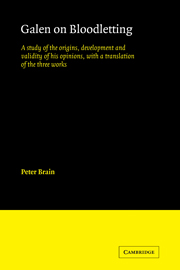 Galen on Bloodletting
Galen on Bloodletting Book contents
- Frontmatter
- Contents
- Preface
- Note on abbreviations and references
- Note on manuscripts and editions
- 1 Galen and his system: an introduction
- 2 Galen's Book on Venesection against Erasistratus (translation)
- 3 Galen's Book on Venesection against the Erasistrateans in Rome (translation)
- 4 Galen's Book on Treatment by Venesection (translation)
- 5 Development of Galen's views and methods as shown in the three works
- 6 Galen, venesection and the Hippocratic Corpus
- 7 Galen's practice of venesection
- 8 Galen's revulsive treatment and vascular anatomy
- 9 The testimony of other writers and the validity of Galen's opinions on sites for venesection
- 10 Galen's use of venesection as an evacuant: can it be justified? A medical digression
- 11 Conclusion
- Glossary
- Works cited
- Index
10 - Galen's use of venesection as an evacuant: can it be justified? A medical digression
Published online by Cambridge University Press: 04 August 2010
- Frontmatter
- Contents
- Preface
- Note on abbreviations and references
- Note on manuscripts and editions
- 1 Galen and his system: an introduction
- 2 Galen's Book on Venesection against Erasistratus (translation)
- 3 Galen's Book on Venesection against the Erasistrateans in Rome (translation)
- 4 Galen's Book on Treatment by Venesection (translation)
- 5 Development of Galen's views and methods as shown in the three works
- 6 Galen, venesection and the Hippocratic Corpus
- 7 Galen's practice of venesection
- 8 Galen's revulsive treatment and vascular anatomy
- 9 The testimony of other writers and the validity of Galen's opinions on sites for venesection
- 10 Galen's use of venesection as an evacuant: can it be justified? A medical digression
- 11 Conclusion
- Glossary
- Works cited
- Index
Summary
An aim of this work has been to examine, not only Galen's opinions on bloodletting, but also the reasons why he held them; it is therefore necessary to consider whether he could have been justified in believing what he did. Galen, like most other practitioners of his time, used phlebotomy as an evacuant remedy in a great variety of diseases; he also employed it as a revulsive in a way that would seem quite incompatible with his knowledge of anatomy, yet which can be shown to have been justified in the light of the knowledge of his time. Is there any scientific justification for his use of venesection as a general evacuant, taking into account that the conditions under which Galen practised were different from those now prevailing? The arguments to be put forward would not be accepted by all authorities today; it is nevertheless however possible for a professional haematologist, making use of discoveries in medicine in the last thirty years, to put up a case of sorts for Galen's use of venesection as an evacuant remedy. Any such retrospective evaluation must, of course, be highly speculative. Two separate arguments can be used; one concerns resistance to infection, while the other is rheological. Infection will be considered first.
Most physicians today, if asked whether there were advantages to the patient in being anaemic, would probably not be able to think of many. And although most would certainly agree that degenerative disease of the heart and arteries is less prevalent in the undernourished, the orthodox view is that impaired nutrition makes for greater susceptibility to infectious disease.
- Type
- Chapter
- Information
- Galen on BloodlettingA Study of the Origins, Development and Validity of his Opinions, with a Translation of the Three Works, pp. 158 - 172Publisher: Cambridge University PressPrint publication year: 1986


